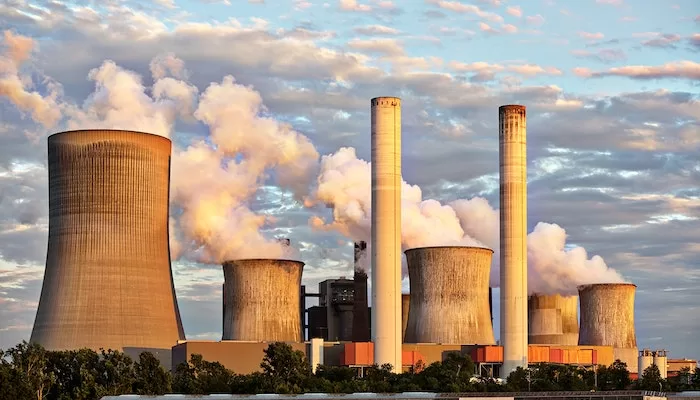Science & Environment
What Impact Do Business Operations Have on Climate Change?

Climate experts have been trying to mount pressure on businesses for several decades to move towards net-zero emissions. Although some companies have reduced their carbon footprints by adjusting their business practices, the numbers are negligible.
However, in the last few years, businesses have slowly realised that climate change can affect their growth. They also realise that business activities, if conducted in an unsustainable manner, directly impact the environment. If you want to understand how your business operations increase your carbon footprint, choose an online course on climate change. Make sure that the course you choose is offered by a well-known institution.
Here are three business processes that adversely impact air, soil and water and contribute to easing carbon emissions and global warming.
1. The Impact of Manufacturing on Climate
The base industries like steel and cement are some of the most significant contributors to greenhouse gas emissions worldwide. To achieve net-zero emissions, these industries will require new technologies.
Manufacturing done in an unsustainable manner has a severe impact on our climate. Many experts claim that nearly two-thirds of the pollution of our planet is directly caused by factories. To manufacture products, many chemicals are required. The waste produced during manufacturing can severely harm our planet’s ecosystem and health.
Some impacts of the manufacturing process on our climate include the following:
- Global Warming
In most manufacturing processes, greenhouse gases like methane and carbon dioxide are released into our atmosphere. These gases can absorb radiation from the sun, raising the planet’s overall temperature. Global warming hugely impacts our climate and environment. It leads to rising sea levels, the risk of many animal and plant species becoming extinct, rising earth temperature, tsunamis, hurricanes, floods, melting ice caps and other natural disasters.
- Air Pollution
Industrial factories release vast amounts of toxic gases into the air. These gases increase the risk of chronic respiratory diseases, heart diseases, lung cancer and other severe illnesses.
- Water Pollution
During the manufacturing process, an enormous amount of wastewater is also released, which is very toxic. Such water contains heavy metals, chemicals and sometimes even radioactive materials. Many companies illegally dump such sewage into our rivers and other water bodies. This has a horrendous impact on marine life and our environment.
- Soil Pollution
The manufacturing process also produces a lot of solid industrial wastes. When these wastes are illegally dumped into landfills, the chemicals and other toxic materials present in the waste leach into the soil and destroy its fertility.
If you want to know how to reduce the impact of manufacturing processes on the climate to the bare minimum, join a reputed climate change online course. Make sure that the chosen course is provided by a reputable institute. Such a course will provide new data and strategies for shifting your business toward net-zero emissions.
2. The Impact of the Packaging Process on Our Environment
The packaging method is a necessary business process that affects the climate adversely. Some significant impacts of the wasteful packaging process on our environment include the following:
- Air Pollution
You contribute to air pollution in several ways when using excess packaging material. For example, extra packaging material must be disposed of through waste incineration. Incinerating such a massive amount of wasteful packaging material creates harmful gases that include hexane, CFCs, Vinyl chloride and CO2.
Additionally, the use of electricity and the transportation of wasteful packaging also lead to increased air pollution. Furthermore, when you dump a considerable amount of waste packaging material in a landfill, it decomposes, releasing CO2 and methane gas into the atmosphere. These gases play a significant role in global warming.
- Birdlife
Experts have calculated that nearly 1 million marine birds die yearly from plastics. The birds ingest plastic either directly or indirectly through the food chain. The excessive amount of plastic in the environment due to throwaway packaging harms the environment’s well-being, harming the lives of birds. It is estimated that there has been a 67% decline in the population of marine birds in the last 60 years alone (source: UBC research).
- Landfill Space
According to an estimate, in 2017, in the UK alone, 9.3 million tonnes of packaging waste was generated (source: Ribble-pack.co.uk). As many of these contain plastic and Styrofoam, it will take an estimated 500 years before they degrade. Such an enormous amount of solid waste is leading to a shortage of landfill sites in the country. These landfill sites can harm the fertility of the soil and endanger the life of insects living there.
- Water Pollution
The overall usage of water for package production is also very high. Furthermore, the waste it produces is a significant source of water pollution. For example, you will need three bottles of water and a quarter bottle of oil to manufacture one plastic water bottle. Similarly, other packaging materials also require a massive amount of water for production. This is a significant waste of our precious water resources.
It is easy to minimise and recycle the packaging material at a meagre cost. However, due to a lack of awareness about the impact of packaging material waste on the environment, companies have not invested heavily enough in recycling. Let’s take the example of the United States alone. The recycling rate for food-service plastic alone accounts for just 28% of their total waste (source: EPA.gov).
3. Logistics – A great Contributor to Greenhouse Gases
Another major contributor to greenhouse gas emissions is the transportation sector. Logistics is an essential part of any business operation. The overall impact of the logistic chain of a business on the climate is quite huge. It is considered one of the significant contributors to carbon emissions.
As the transport sector guzzles fossil fuels in immense quantities, more CO2 is released into the atmosphere. Additionally, vehicles, trains or planes also cause noise pollution, which greatly impacts our health.
Optimising the logistic chain means your business will require fewer trucks or ships to move your products. If you can plan your supply chain strategically, you can ensure that your transport assets also cover fewer miles.
Conclusion
Business is a big part of our social structure and depends on natural and man-made systems to sustain itself. Environmental disruptions can have a massive impact on its sustainability. Therefore, businesses should proactively reduce their environmental footprint for long-term sustainability.
To understand the cause and effect of climate change on business, take a short climate change online course from a reputable institution. It will help you to gain a better perspective of the situation. It will also give you the requisite knowledge and tools to align your business policies and match your commitment to achieving growth without affecting nature.

























































